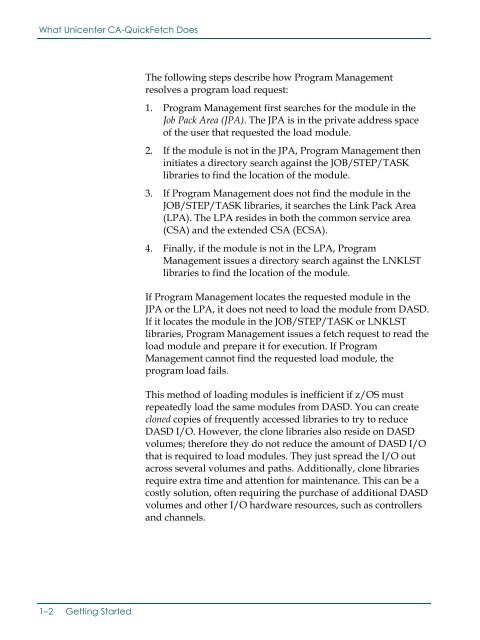Unicenter CA-QuickFetch Getting Started
Unicenter CA-QuickFetch Getting Started
Unicenter CA-QuickFetch Getting Started
You also want an ePaper? Increase the reach of your titles
YUMPU automatically turns print PDFs into web optimized ePapers that Google loves.
What <strong>Unicenter</strong> <strong>CA</strong>-<strong>QuickFetch</strong> DoesThe following steps describe how Program Managementresolves a program load request:1. Program Management first searches for the module in theJob Pack Area (JPA). The JPA is in the private address spaceof the user that requested the load module.2. If the module is not in the JPA, Program Management theninitiates a directory search against the JOB/STEP/TASKlibraries to find the location of the module.3. If Program Management does not find the module in theJOB/STEP/TASK libraries, it searches the Link Pack Area(LPA). The LPA resides in both the common service area(CSA) and the extended CSA (ECSA).4. Finally, if the module is not in the LPA, ProgramManagement issues a directory search against the LNKLSTlibraries to find the location of the module.If Program Management locates the requested module in theJPA or the LPA, it does not need to load the module from DASD.If it locates the module in the JOB/STEP/TASK or LNKLSTlibraries, Program Management issues a fetch request to read theload module and prepare it for execution. If ProgramManagement cannot find the requested load module, theprogram load fails.This method of loading modules is inefficient if z/OS mustrepeatedly load the same modules from DASD. You can createcloned copies of frequently accessed libraries to try to reduceDASD I/O. However, the clone libraries also reside on DASDvolumes; therefore they do not reduce the amount of DASD I/Othat is required to load modules. They just spread the I/O outacross several volumes and paths. Additionally, clone librariesrequire extra time and attention for maintenance. This can be acostly solution, often requiring the purchase of additional DASDvolumes and other I/O hardware resources, such as controllersand channels.1–2 <strong>Getting</strong> <strong>Started</strong>
















